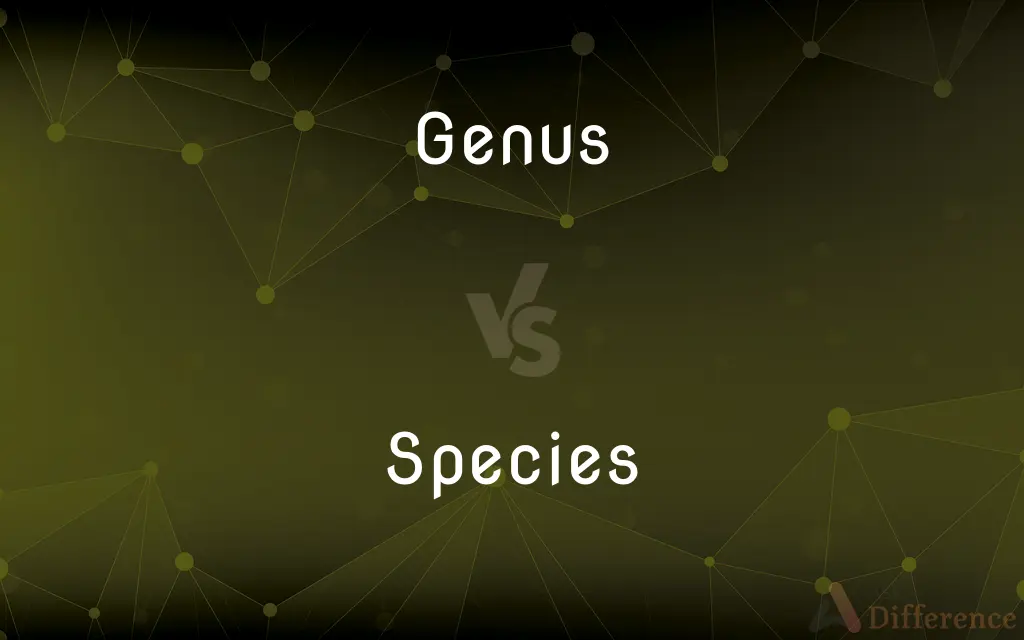Genus vs. Species — What's the Difference?
By Tayyaba Rehman — Updated on October 25, 2023
Genus is a classification rank above species grouping related species together, while species is the basic unit of classification representing a group of individuals that can interbreed.

Difference Between Genus and Species
Table of Contents
ADVERTISEMENT
Key Differences
Genus and species are two fundamental classifications in the biological taxonomy hierarchy. The Genus is a rank that sits above species, and it's used to categorize a group of species that are structurally similar or common in some way. Species, conversely, represents the most specific level of classification, focusing on organisms that can potentially interbreed and produce fertile offspring under natural conditions.
When naming organisms using binomial nomenclature, both genus and species play crucial roles. The genus is always capitalized and is the first part of the two-part scientific name, while the species is the second part and is never capitalized. For instance, in Homo sapiens, "Homo" is the genus and "sapiens" is the species.
Understanding the distinction between genus and species is paramount in the realm of biological studies. When scientists refer to a genus, they might be discussing a variety of species that share certain characteristics, but those species may still have significant differences. Species, on the other hand, zeroes in on a very specific group of organisms that share a high degree of similarity and can usually breed among themselves.
While genus groups related species based on certain shared characteristics, species delves deeper, defining a group based on reproductive capabilities. For example, within the genus Canis, there are different species like Canis lupus (wolf) and Canis familiaris (domestic dog).
To sum it up, genus and species are both vital to the taxonomy of organisms. The genus offers a broader categorization, encompassing multiple species that have structural similarities or evolutionary ties. Species pinpoints a distinct population of organisms that are capable of interbreeding under natural circumstances.
ADVERTISEMENT
Comparison Chart
Classification Rank
Higher rank grouping related species.
Basic unit representing interbreeding individuals.
Binomial Nomenclature
First part, always capitalized.
Second part, never capitalized.
Examples
Homo in Homo sapiens.
Sapiens in Homo sapiens.
Interbreeding
Doesn't necessarily imply interbreeding capability.
Indicates potential for interbreeding and producing fertile offspring.
Scope
Broader categorization based on shared traits.
More specific, based on reproductive capabilities and high genetic similarity.
Compare with Definitions
Genus
A group of species with similar characteristics.
Different species of roses belong to the genus Rosa.
Species
The basic unit in taxonomy, representing interbreeding organisms.
The species sapiens denotes modern humans.
Genus
A rank in the classification of organisms, grouping together related species.
The genus Panthera includes big cats like lions and tigers.
Species
A group of living organisms that can interbreed to produce fertile offspring.
Canis lupus is the species name for the gray wolf.
Genus
A taxonomic rank below family and above species.
The genus Aptenodytes includes various species of penguins.
Species
A distinct group in terms of genetics, morphology, or other characteristics.
The cheetah is a species known for its incredible speed.
Genus
Genus (plural genera) is a taxonomic rank used in the biological classification of living and fossil organisms as well as viruses. In the hierarchy of biological classification, genus comes above species and below family.
Species
A categorization of organisms based on shared genetic traits.
Despite their differences, all humans belong to the same species.
Genus
The first part of the binomial name of an organism.
In Panthera leo, the genus is Panthera.
Species
In biology, a species is the basic unit of classification and a taxonomic rank of an organism, as well as a unit of biodiversity. A species is often defined as the largest group of organisms in which any two individuals of the appropriate sexes or mating types can produce fertile offspring, typically by sexual reproduction.
Genus
A principal taxonomic category that ranks above species and below family, and is denoted by a capitalized Latin name, e.g. Leo.
Species
A group of living organisms consisting of similar individuals capable of exchanging genes or interbreeding. The species is the principal natural taxonomic unit, ranking below a genus and denoted by a Latin binomial, e.g. Homo sapiens.
Genus
(Biology) A taxonomic category ranking below a family and above a species and designating a group of species that are presumed to be closely related and usually exhibit similar characteristics. In a scientific name, the genus name is capitalized and italicized, for example, Ovis for sheep and related animals.
Species
A kind or sort
A species of invective at once tough and suave
Genus
(Logic) A class of objects divided into subordinate species having certain common attributes.
Species
The visible form of each of the elements of consecrated bread and wine in the Eucharist.
Genus
A class, group, or kind with common attributes.
Species
(Biology) A group of closely related organisms that are very similar to each other and are usually capable of interbreeding and producing fertile offspring. The species is the fundamental category of taxonomic classification, ranking below a genus or subgenus. Species names are represented in binomial nomenclature by an uncapitalized Latin adjective or noun following a capitalized genus name, as in Ananas comosus, the pineapple, and Equus caballus, the horse.
Genus
A category in the classification of organisms, ranking below family (Lat. familia) and above species.
All magnolias belong to the genus Magnolia.
Other species of the genus Bos are often called cattle or wild cattle.
There are only two genera and species of seadragons.
Species
(Logic) A class of individuals or objects grouped by virtue of their common attributes and assigned a common name; a division subordinate to a genus.
Genus
A taxon at this rank.
Species
(Chemistry) A set of atoms, molecules, ions, or other chemical entities that possess the same distinct characteristics with respect to a chemical process or measurement.
Genus
A group with common attributes.
Species
A kind, variety, or type
"No species of performing artist is as self-critical as a dancer" (Susan Sontag).
Genus
A natural number representing any of several related measures of the complexity of a given manifold or graph.
Species
The outward appearance or form of the Eucharistic elements that is retained after their consecration.
Genus
(semantics) Within a definition, a broader category of the defined concept.
Species
Either of the consecrated elements of the Eucharist.
Genus
(music) A type of tuning or intonation, used within an Ancient Greek tetrachord.
Species
Type or kind. race.}}
The male species
A new species of war
Genus
A class of objects divided into several subordinate species; a class more extensive than a species; a precisely defined and exactly divided class; one of the five predicable conceptions, or sorts of terms.
Species
A group of plants or animals having similar appearance.
This species of animal is unique to the area.
Genus
An assemblage of species, having so many fundamental points of structure in common, that in the judgment of competent scientists, they may receive a common substantive name. A genus is not necessarily the lowest definable group of species, for it may often be divided into several subgenera. In proportion as its definition is exact, it is natural genus; if its definition can not be made clear, it is more or less an artificial genus.
Species
A category in the classification of organisms, ranking below genus; a taxon at that rank.
Genus
A general kind of something;
Ignore the genus communism
Species
A particular type of atom, molecule, ion or other particle.
Genus
(biology) taxonomic group containing one or more species
Species
(mineralogy) A mineral with a unique chemical formula whose crystals belong to a unique crystallographic system.
Genus
A way to categorize organisms based on evolutionary relationships.
The genus Canis includes species like dogs and wolves.
Species
An image, an appearance, a spectacle.
Species
(obsolete) The image of something cast on a surface, or reflected from a surface, or refracted through a lens or telescope; a reflection.
I cast the species of the Sun onto a sheet of paper through a telescope.
Species
Visible or perceptible presentation; appearance; something perceived.
Species
(Christianity) Either of the two elements of the Eucharist after they have been consecrated.
Species
Coin, or coined silver, gold, or other metal, used as a circulating medium; specie.
Species
A component part of compound medicine; a simple.
Species
Plural of specie
Species
Visible or sensible presentation; appearance; a sensible percept received by the imagination; an image.
Wit, . . . the faculty of imagination in the writer, which searches over all the memory for the species or ideas of those things which it designs to represent.
Species
A group of individuals agreeing in common attributes, and designated by a common name; a conception subordinated to another conception, called a genus, or generic conception, from which it differs in containing or comprehending more attributes, and extending to fewer individuals. Thus, man is a species, under animal as a genus; and man, in its turn, may be regarded as a genus with respect to European, American, or the like, as species.
Species
In science, a more or less permanent group of existing things or beings, associated according to attributes, or properties determined by scientific observation.
Species
A sort; a kind; a variety; as, a species of low cunning; a species of generosity; a species of cloth.
Species
Coin, or coined silver, gold, or other metal, used as a circulating medium; specie.
There was, in the splendor of the Roman empire, a less quantity of current species in Europe than there is now.
Species
A public spectacle or exhibition.
Species
A component part of a compound medicine; a simple.
Species
The form or shape given to materials; fashion or shape; form; figure.
Species
(biology) taxonomic group whose members can interbreed
Species
A specific kind of something;
A species of molecule
A species of villainy
Species
The second part of the binomial name of an organism.
In the name Homo sapiens, sapiens is the species.
Common Curiosities
How are organisms scientifically named using genus and species?
Organisms are named using binomial nomenclature, with the genus capitalized followed by the species in lowercase.
What is a genus in biological taxonomy?
A genus is a rank in taxonomy that groups together related species based on shared characteristics.
Is the species name ever capitalized?
No, in binomial nomenclature, the species name is always written in lowercase.
Can there be multiple species within a genus?
Yes, a genus can comprise multiple species that share certain similarities.
Can a species belong to multiple genera?
No, a species belongs to only one genus.
What comes above genus in the taxonomy hierarchy?
The rank above genus is "family."
Can two different species under the same genus interbreed?
While some species within the same genus can interbreed, the offspring (like mules) are often infertile.
Do species within the same genus look identical?
No, species within the same genus can vary, but they share certain structural or evolutionary traits.
What is the main factor that defines a species?
The primary factor is the ability of individuals to interbreed and produce fertile offspring.
How specific is the classification of a species?
A species is the most specific level of classification, representing organisms that can interbreed.
How is a new species defined?
A new species is typically defined based on genetic differences and the inability to interbreed with other species.
Are genus and species classifications fixed?
No, as scientific knowledge evolves, classifications can change based on new findings.
Why is the genus name always capitalized?
It's a convention in binomial nomenclature to differentiate the genus from the species.
How are genus and species used in naming extinct organisms?
Extinct organisms are also named using binomial nomenclature, relying on fossil records and evolutionary analysis.
How many species can a genus contain?
A genus can contain one to many species, depending on similarities and evolutionary relationships.
Share Your Discovery

Previous Comparison
Willing vs. Wanting
Next Comparison
Slander vs. GossipAuthor Spotlight
Written by
Tayyaba RehmanTayyaba Rehman is a distinguished writer, currently serving as a primary contributor to askdifference.com. As a researcher in semantics and etymology, Tayyaba's passion for the complexity of languages and their distinctions has found a perfect home on the platform. Tayyaba delves into the intricacies of language, distinguishing between commonly confused words and phrases, thereby providing clarity for readers worldwide.















































